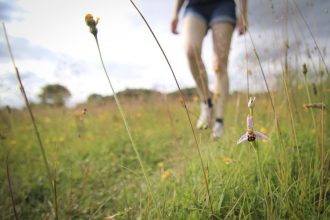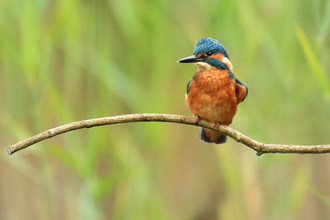Lockdown was a stressful and scary time for many of us, but it also brought some unexpected highlights. With less traffic on the roads we could hear the birdsong properly, and it was almost as if the dawn chorus carried triumphantly on throughout the whole day. Bees had a bonanza as fewer traffic fumes meant they could smell the flowers more strongly, and people everywhere began noticing the nature that had been on their doorstep all along, waiting to be discovered. Our nature reserves were no exception, with plenty of wonderful wildlife sightings recorded throughout July.
Latest wildlife sightings – July 2020
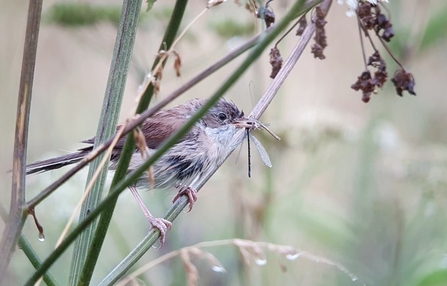
Whitethroat eating a common blue damselfly, by in focus
Brockholes
It’s that time of year at Brockholes Nature Reserve – dragonfly drama a-plenty! Visitors enjoyed watching common darter, brown hawker, southern hawker, emperor and black tailed skimmer dragonflies zooming over the lakes and pools like fighter pilots in hot pursuit of their insect prey. Butterflies, too, delighted us all with their colourful fluttering, including:
- Comma
- Small tortoiseshell
- Peacock
- Small white
- Speckled wood
- Common blue
- Small skipper
- Small copper
- White-letter hairstreak – one of the highlights of the Brockholes year
And we can’t forget the moths – a dingy footman (the first record for the reserve) was spotted at rest, as well as a stunning mother of pearl moth.
Brockholes’ feathered residents delighted us all, including the in focus team who are set up in the Meadow Lake Suite and captured this fantastic picture of a whitethroat dining on a common blue damselfly for breakfast. Goldfinches chatted to one another in the trees, barn owls hunted in the meadows and a juvenile cuckoo was spotted by one eagle-eyed visitor. Most exciting of all, we were able to switch on the Tern Raft Camera and broadcast the hatching of a brood of common tern chicks live through our website.
Mere Sands Wood
Mere Sands Wood, in Rufford, is a wonderful place to visit at any time of the year, but this Lancashire nature reserve really comes into its own during the spring and summer months. In July, the abundance of dragonflies hawking over the lakes attracted a hobby – a small falcon with aerobatic skills to rival the dragons and damsels it preys on.
Some visitors were lucky enough to catch sight of a family of kingfishers fishing and feeding their young, while another walker was surprised to find a burying beetle making its way across the boardwalk! These brightly-striped beetles are also known as Sexton beetles. They’re incredible recyclers; disposing of dead animals by dragging them down into their burrows.
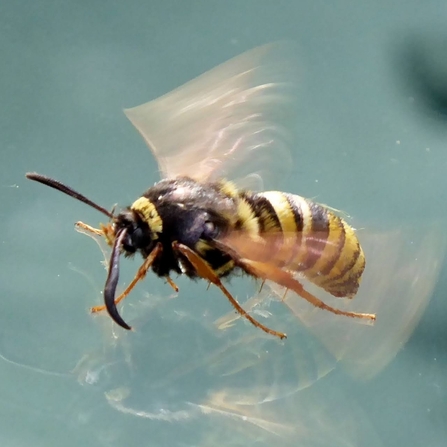
Lunar hornet moth, by Heysham Bird Observatory
Middleton Nature Reserve
If there’s one place to see insects this summer, it’s Middleton Nature Reserve. July was a wonderful haze of dragonflies:
- Black-tailed skimmer
- Brown hawker
- Emperor
- Common darter
- Broad-bodied chaser
- Southern hawker
While there were plenty of butterflies feeding from wildflowers, too:
- Meadow brown
- Ringlet
- Small skipper
- Gatekeeper
- Common blue
- Comma
- Brimstone
Perhaps the most impressive sightings, however, were of lunar hornet moths attracted to lures – a first record for the Heysham area! These fascinating moths usually overwinter twice as larvae. The caterpillars feed close to the ground in their first year, then move slightly higher up their chosen tree trunk in their second year.
July’s bird records were encouraging, too, with singing willow warblers, chiffchaffs, blackcaps and sedge warblers all recorded. A Cetti’s warbler was heard singing on the central marsh, while whitethroats and a lesser whitethroat were also spotted. We even had a little owl on-site, which is the first record for many years now.
Heysham harbour
There is always so much to see from Heysham harbour and July was no exception. Scouting around the harbour and looking out to sea revealed kittiwakes near the north harbour wall, gannets feeding out amongst the waves, and a fulmar out past Round Head. It’s turning out to be a pretty good year for these birds locally: there were just four records of fulmar in 2019, but so far this year we’ve had 26!
Eagle-eyed Heysham Bird Observatory staff spotted a great skua from the stone jetty alongside Manx shearwaters, Arctic terns and more gannets. Over at Red Nab it was wonderful to see the sea holly in bloom and a whimbrel roosting with the curlews. A sandwich tern was recorded flying over No. 1 Outflow, while over on Heysham skeer, staff and visitors spotted little egrets, turnstones, redshank and five eider ducks.
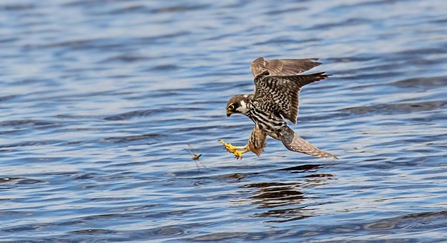
Hobby hunting a dragonfly, by Andy Morffew
Lunt Meadows
Lunt Meadows in Merseyside is a birder’s paradise – as July demonstrates! Rob Williams spotted a Caspian tern (the first record for the reserve) over Pump Pool before it was chased off by black-headed gulls. There was also something of a baby boom, with avocets, tufted ducks and shelducks all raising chicks at Lunt Meadows. Visitors even spotted a juvenile cuckoo.
The wet grassland saw more than 100 lapwings arrive to feed and roost alongside redshank, black-tailed godwits, snipe and little ringed plovers. Another new record for the reserve was a ruddy shelduck, known in India as the Brahminy duck.
The beautiful July weather brought good numbers of dragonflies out at Lunt Meadows, with countless black-tailed skimmers, and smaller numbers of four-spotted chasers, large red damselflies and banded demoiselles seen flying across the reserve. Of course, this was a veritable buffet for birds like the hobby, and visitors were pleased to spot a hobby hunting at Lunt Meadows last month.
Wigan Flashes
July is an equally wonderful month to spot wildflowers as well as insects, and Wigan Flashes has them in abundance. Just a couple of highlights from the past few weeks include marsh helleborine – a striking orchid with white, frilly-edged flowers with a yellow spot and purplish-red centre – and a large number of common spotted orchids, undoubtedly one of our most beautiful orchid species. Staff also spotted yellow bird’s nest in the woods. This rare, fungi-like plant thrives in damp wooded areas and is incredibly unusual among plants. Rather than containing chlorophyll it is a myco-heterotroph, which means that it feeds by parasitizing fungi rather than using photosynthesis.
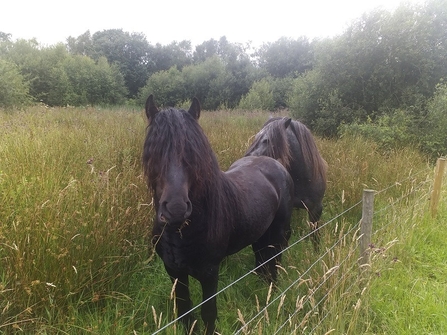
Seth and Frankie the Astley Moss fell ponies
Chat Moss
It’s been a busy summer season across the Chat Moss peatlands. Of course, May and June saw us release our brood of large heath (also known as Manchester argus) butterflies; reintroducing them after an absence of more than 150 years! July, too, was a great time to spot butterflies across nature reserves including Little Woolden Moss and Astley Moss, with plenty of small tortoiseshells and painted ladies making the most of the available nectar. Cinnabar moth caterpillars were out feasting on ragwort in force, and visitors were charmed by the fluffy heads of common cottongrass and hare’s-tail cottongrass bobbing in the breeze.
We also welcomed two brand new members of the Astley Moss conservation team in July – Seth and Frankie the fell ponies! They’ll munch their way through some of the larger rushes and bindweed in the fenland habitat on-site, allowing more native plant species like meadow buttercup, violets and orchids to flourish.
With all of our nature reserves now open once more, why not head out and see what kind of wildlife you can spot during August? Remember to stay safe by wearing a mask or face covering in bird hides and walking in the direction of any signposted one-way systems, and protect the wildlife that shares these wild spaces by sticking to footpaths and keeping dogs on a lead.
Let us know what you spot by getting in touch on Facebook, Twitter or Instagram!


